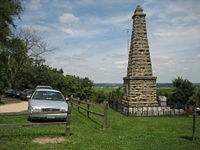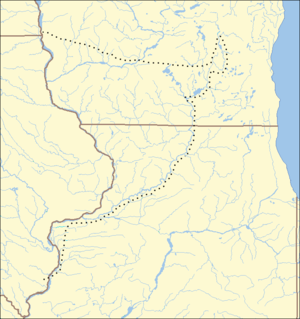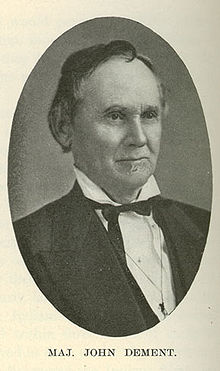
The Black Hawk War was a conflict between the United States and Native Americans led by Black Hawk, a Sauk leader. The war erupted after Black Hawk and a group of Sauks, Meskwakis (Fox), and Kickapoos, known as the "British Band", crossed the Mississippi River, to the U.S. state of Illinois, from Iowa Indian Territory in April 1832. Black Hawk's motives were ambiguous, but he was apparently hoping to reclaim land that was taken over by the United States in the disputed 1804 Treaty of St. Louis.

Black Hawk, born Ma-ka-tai-me-she-kia-kiak, was a Sauk leader and warrior who lived in what is now the Midwestern United States. Although he had inherited an important historic sacred bundle from his father, he was not a hereditary civil chief. Black Hawk earned his status as a war chief or captain by his actions: leading raiding and war parties as a young man and then a band of Sauk warriors during the Black Hawk War of 1832.

The Bad Axe Massacre was a massacre of Sauk (Sac) and Meskwaki (Fox) Native Americans by United States Army regulars and militia that occurred on August 1–2, 1832. This final scene of the Black Hawk War took place near present-day Victory, Wisconsin, in the United States. It marked the end of the war between white settlers and militia in Illinois and Michigan Territory, and the Sauk and Fox tribes under warrior Black Hawk.

The Battle of Stillman's Run, also known as the Battle of Sycamore Creek or the Battle of Old Man's Creek, occurred in Illinois on May 14, 1832. The battle was named for the panicked retreat by Major Isaiah Stillman and his detachment of 275 Illinois militia after being attacked by an unknown number of Sauk warriors of Black Hawk's British Band. The numbers of warriors has been estimated at as few as fifty but as many as two hundred participated in the attack. However, reports found in Whitney's Black Hawk War indicated that large numbers of Indians were on the move throughout the region, and it appeared that widespread frontier warfare was underway. The engagement was the first battle of the Black Hawk War (1832), which developed after Black Hawk crossed the Mississippi River from Iowa into Illinois with his band of Sauk and Fox warriors along with women, children, and elders to try to resettle in Illinois. The militia had pursued a small group of Sauk scouts to the main British Band camp following a failed attempt by Black Hawk's emissaries to negotiate a truce.

The Buffalo Grove ambush was an ambush that occurred on May 19, 1832 as part of the Black Hawk War. A six-man detail carrying dispatches from United States Colonel James M. Strode at Galena, Illinois to General Henry Atkinson at Dixon's Ferry was ambushed by Native Americans during the attack. William Durley was killed and buried near the site of the ambush. Durley's remains were initially interred by the party that would become victims of the St. Vrain massacre. Two other men had bullet holes in their clothing, but were uninjured. In 1910 the Polo Historical Society moved Durley's remains to a plot beneath a memorial they erected west of Polo, Illinois.
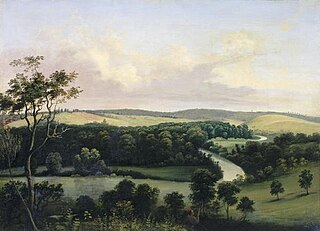
The Battle of Horseshoe Bend, also referred to as the Battle of Pecatonica and the Battle of Bloody Lake, was fought on June 16, 1832, in present-day Wisconsin at an oxbow lake known as "Horseshoe Bend", which was formed by a change in course of the Pecatonica River. The battle was a major turning point in the Black Hawk War, despite being of only minor military significance. The small victory won by the U.S. militia at Horseshoe Bend helped restore public confidence in the volunteer force following an embarrassing defeat at Stillman's Run. The Battle of Horseshoe Bend ended with three militia men killed in action and a party of eleven Kickapoo warriors dead.

The Spafford Farm massacre, also referred to as the Wayne massacre, was an attack upon U.S. militia and civilians that occurred as part of the Black Hawk War near present-day South Wayne, Wisconsin. Spafford Farm was settled in 1830 by Omri Spafford and his partner Francis Spencer.

Stillman's Run Battle Site is a site in Stillman Valley, Illinois. It is listed on the National Register of Historic Places and has been since December 1983. The Battle of Stillman's Run was an 1832 clash between the Illinois militia and Black Hawk and his Sauk Indian Band. The battle took place in 1832 as part of the Black Hawk War. During the engagement 12 militia men were killed while making a stand on a small hill. The rest of the militia fled back to Dixon's Ferry where they spread news of a terrible slaughter at Stillman's Run.
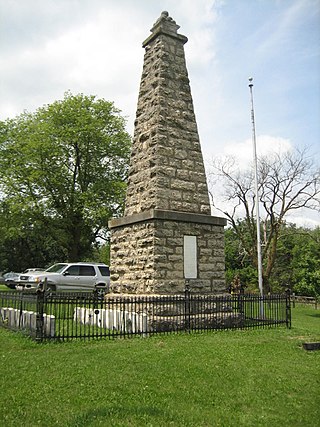
Kellogg's Grove is an area in western Stephenson County, Illinois, United States near the present-day unincorporated town of Kent. The grove is considered historically significant because it was the site of two minor skirmishes during the Black Hawk War in 1832. Today, most of the grove is privately owned but 1.5 acres (6,100 m2) are allocated as a park owned by Stephenson County. While most of the battle occurred on what is today private property the park contains a monument dedicated to the battle and cemetery with the graves of several militia members killed during the skirmish at Kellogg's Grove. The cemetery also holds the graves of those killed in other area battles. The Kellogg's Grove battle site was added to the U.S. National Register of Historic Places in 1978.
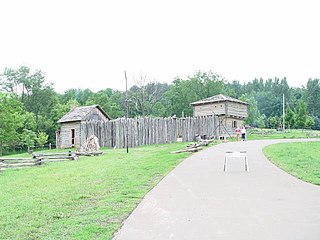
The Battle of Apple River Fort, occurred on the late afternoon of June 24, 1832 at the Apple River Fort, near present-day Elizabeth, Illinois, when Black Hawk and 200 of his "British Band" of Sauk and Fox were surprised by a group of four messengers en route from Galena, Illinois. One of the couriers was wounded in the thigh as the riders quickly made for the protection of the nearby stockade. Courier Fred Dixon lagged behind and provided cover for his comrades. The other couriers rode ahead to warn some 70 settlers of the approaching Sauk and Fox, thus saving their lives. The small company of militia at the fort, about 28-30 men and boys led by Captain Clack Stone, fought off Black Hawk's 150-man war party in an action that lasted about an hour. The withering pace of the gunfire eventually convinced Black Hawk that the fort was too heavily defended to lead a direct attack. He considered burning the fort, then switched to raiding cabins of foodstuffs, clothing and cooking utensils. In the gathering darkness, Black Hawk and his war party retreated.

The Battle of Wisconsin Heights was the penultimate engagement of the 1832 Black Hawk War, fought between the United States state militia and allies, and the Sauk and Fox tribes, led by Black Hawk. The battle took place in what is now Dane County, near present-day Sauk City, Wisconsin. Despite being vastly outnumbered and sustaining heavy casualties, Black Hawk's warriors managed to delay the combined government forces long enough to allow the majority of the Sauk and Fox civilians in the group to escape across the Wisconsin River. This reprieve was temporary; when the militia finally caught up with the fleeing band it resulted in the Bad Axe massacre at the mouth of the Bad Axe River.

The Battle of Waddams Grove, also known as the Battle of Yellow Creek was part of the Black Hawk War. It took place in present-day Stephenson County, Illinois on June 18, 1832. After several incidents of Sauk Indian raids on settlers along the Apple River, Captain James W. Stephenson left Galena with a group of volunteer militia in pursuit of the Native party. The group clashed on June 18, 1832 near Yellow Creek and the ensuing battle descended into a bayonet and knife fight in which several Sauk and three militia men were killed. Stephenson was severely wounded by a musketball to the chest during the fighting. The dead were eventually interred in a memorial cemetery in Kellogg's Grove, Illinois where a stone monument was erected in memory of those killed during the war.
The Sinsinawa Mound raid occurred on June 29, 1832, near the Sinsinawa mining settlement in Michigan Territory. This incident, part of the Black Hawk War, resulted in the deaths of two men; a third man survived by seeking cover in a nearby blockhouse. In the aftermath of the raid, Captain James W. Stephenson set out to pursue the attackers—a straggling band of Sauk Native Americans—but lost their trail at the Mississippi River. The attack occurred in the same week as other skirmishes and raids, and as a result helped contribute to the growing fear in the region. The raid caused the residents of nearby Platteville to consider fleeing their settlement.
The Plum River raid was a bloodless skirmish that occurred at present-day Savanna, Illinois, on May 21, 1832, as part of the Black Hawk War. Most of the settlement's inhabitants, except for a few defenders, had fled for Galena, Illinois, before the raid happened. A small band of Native Americans, either Sauk or Fox, attacked the settlement while only three of the six defenders were present. The men who were present fell back to the blockhouse and a firefight ensued for about one hour, after which the attackers withdrew. No one was killed or injured during the attack, but in its aftermath Colonel James M. Strode dispatched a detachment of militia to Savanna. They returned to Galena without incident and the settlement at Savanna was temporarily abandoned.
James D. Henry was a militia officer from the U.S. state of Illinois who rose to the rank of general during the Black Hawk War. Henry was born in Pennsylvania in 1797, and moved to Edwardsville, Illinois in 1822. In 1825, while living in Edwardsville, he was indicted with two other men for the murder of an acquaintance, though he never went to trial. One defendant was tried but found not guilty, and following the trial Henry moved to Springfield, Illinois, where he was elected sheriff. When the Winnebago War broke out in 1827 Henry acted as adjutant for four companies of volunteers.

The Wisconsin Heights Battlefield is an area in Dane County, Wisconsin, where the penultimate battle of the 1832 Black Hawk War occurred. The conflict was fought between the Illinois and Michigan Territory militias and Sauk chief Black Hawk and his band of warriors, who were fleeing their homeland following the Fox Wars. The Wisconsin Heights Battlefield is the only intact battle site from the Indian Wars in the U.S. Midwest. Today, the battlefield is managed and preserved by the state of Wisconsin as part of the Lower Wisconsin State Riverway. In 2002, it was listed on the U.S. National Register of Historic Places.

John Dement was an American politician and militia commander from the U.S. state of Illinois.

The British Band was a mixed-nation group of Native Americans commanded by the Sauk leader Black Hawk, which fought against Illinois and Michigan Territory militias during the 1832 Black Hawk War. The band was composed of about 1,500 men, women, and children from the Sauk, Meskwaki, Fox, Kickapoo, Potawatomi, Ho-Chunk, and Ottawa nations; about 500 of that number were warriors. Black Hawk had an alliance with the British that dated from the War of 1812, giving them their colloquial name. The band crossed the Mississippi River from Iowa into Illinois in an attempt to reclaim their homeland and in violation of several treaties. Subsequently, both the Illinois and Michigan Territory militia were called up and the Black Hawk War ensued.
After the outbreak of the Black Hawk War, at the Battle of Stillman's Run in May 1832, there were minor attacks and skirmishes throughout the duration of the conflict. The war was fought between white settlers in Illinois and present-day Wisconsin and Sauk Chief Black Hawk. The relatively minor attacks of the war were widely dispersed and often carried out by bands of Native Americans that were unaffiliated with Black Hawk's British Band.

Abraham Lincoln served as a volunteer in the Illinois Militia April 21, 1832 – July 10, 1832, during the Black Hawk War. Lincoln never saw combat during his tour but was elected captain of his first company. He was also present in the aftermath of two of the war's battles, where he helped to bury the militia dead. He was mustered in and out of service during the war, going from captain to private and finishing his service in an independent spy company commanded by Captain Jacob Early.
